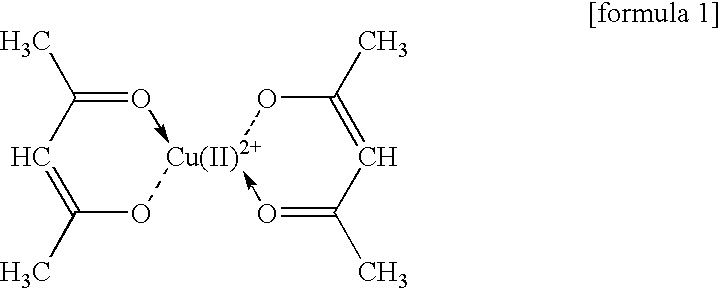Conductive Metal Paste
a technology of metal paste and conductive metal, which is applied in the direction of non-metal conductors, conductors, natural mineral layered products, etc., can solve the problems of not being compatible with ceramic materials other than glass materials, limited heat treatment temperature, and high heat treatment temperature, so as to improve adherence and improve conductive performance , excellent adhesion to the underlying substrate surfa
- Summary
- Abstract
- Description
- Claims
- Application Information
AI Technical Summary
Benefits of technology
Problems solved by technology
Method used
Image
Examples
example 1
Acetylacetonate Complex of Copper (II)
[0073]
An amine solution containing bis(2,4-pentadionate)Cu(II) presented above is prepared in accordance with the following procedure.
[0074]Ten grams of bis(2,4-pentadionate)Cu(II) (molecular weight 261.76; Tokyo Chemical Industry), 50 g of N,N-dibutylaminopropylamine (boiling point 238° C.; Koei Chemical), 50 g of toluene (boiling point 110.6° C.), and methanol (boiling point 64.65° C.) are heated to 60° C. for 30 minutes with stirring, thereby dissolving bis(2,4-pentadionate)Cu(II) in this mixed solvent. From this solution, toluene and methanol are distilled out by the reduced-pressure distillation.
[0075]The solution after the above described distillation becomes a solution having a green color, whose weight is 60 g, and also becomes an amine solution of bis(2,4-pentadionate)Cu(II). A content ratio of Cu in this solution is 4.06% by mass.
[0076]A commercially available dispersion liquid of silver ultra-fine particles (brand name: independent di...
example 2
Carboxylate of Copper(II)
[0083]
An amine solution containing copper(II) 2-ethyl hexanoate presented above is prepared in accordance with the following procedure.
[0084]Ten grams of copper(II) 2-ethyl hexanoate (reagent: Wako Pure Chemical Industries, molecular weight 349.69, purity 98%), 50 g of N,N-dibutylaminopropylamine (molecular weight 186, boiling point 231° C.; Koei Chemical), 50 g of toluene (boiling point 110.6° C.), and methanol (boiling point 64.65° C.) are heated to 60° C. for 10 minutes with stirring, thereby dissolving copper(II) 2-ethyl hexanoate in this mixed solvent. From this solution, toluene and methanol are distilled out by the reduced-pressure distillation.
[0085]The solution after the above described distillation becomes a solution having a green color, whose weight is 60 g, and also becomes an amine solution of copper(II) 2-ethyl hexanoate. A content ratio of Cu in this solution is 4.45% by mass.
[0086]A commercially available dispersion liquid of silver ultra-fi...
example 3
Carboxylate of Bismuth(II)
[0094]
An amine solution containing bismuth(II) 2-ethyl hexanoate presented above is prepared in accordance with the following procedure.
[0095]Ten grams of bismuth(II) 2-ethyl hexanoate / 2-ethyl hexanoic acid solution (reagent: Wako Pure Chemical Industries, bismuth content ratio 25%), 50 g of N,N-dibutylaminopropylamine (boiling point 238° C.; Koei Chemical), 50 g of toluene (boiling point 110.6° C.), and methanol (boiling point 64.65° C.) are heated to 60° C. for 10 minutes with stirring, thereby dissolving bismuth(II) 2-ethyl hexanoate in this mixed solvent. From this solution, toluene and methanol are distilled out by the reduced-pressure distillation.
[0096]The solution after the above described distillation becomes a clear solution having a yellow color, whose weight is 60 g, and also becomes an amine solution of bismuth(II) 2-ethyl hexanoate. A content ratio of Bi in this solution is 4.17% by mass.
[0097]A commercially available dispersion liquid of silv...
PUM
| Property | Measurement | Unit |
|---|---|---|
| particle size | aaaaa | aaaaa |
| particle size | aaaaa | aaaaa |
| temperature | aaaaa | aaaaa |
Abstract
Description
Claims
Application Information
 Login to View More
Login to View More - R&D
- Intellectual Property
- Life Sciences
- Materials
- Tech Scout
- Unparalleled Data Quality
- Higher Quality Content
- 60% Fewer Hallucinations
Browse by: Latest US Patents, China's latest patents, Technical Efficacy Thesaurus, Application Domain, Technology Topic, Popular Technical Reports.
© 2025 PatSnap. All rights reserved.Legal|Privacy policy|Modern Slavery Act Transparency Statement|Sitemap|About US| Contact US: help@patsnap.com



